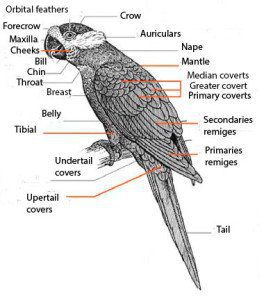Content |
|---|
Description:

15 cm.. length.
The Brown-backed Parrotlet (Touit melanonotus) has the forecrown, the lower cheeks, the sides of neck, the crown and the rear of the neck, grass-green; lores and upper cheeks paler and more yellowish green; ear-coverts brown. Mantle, back and center rump dull blackish-brown color; scapulars, sides rump and uppertail-coverts green.
Inner coverts and median, alula and primary coverts, blackish brown (the latter with narrow green margins at the outerweb); other coverts greenish brown grass. Tertiary brown. Flight feathers green on the outerweb with black opaque brown at the tips and innerwebs. Underwing, with coverts dull green, flight feather, pale grayish green. Chin yellowish; underparts pale grayish green, blur on the sides of chest. Upper, the tail centrally green with black spot on the tips of the outerweb. Outer feathers bright red at the base with broad black subterminal bands and a small green patch tips; undertail, the tail pale green tones and duller with greyish stain on the tip, pale red in outer featherss. Bill yellow distally, greyer towards base; irises grey; legs grey.
The females may show duller bluish-grey on underparts. Immature not described.
- Sound of the Brown-backed Parrotlet.
Habitat:
Mainly reported in humid forests on the lower mountain slopes. Most of the records are in altitudes between 500-1.000 m (1.400 metres in the Itatiaia National Park), but some are lowlands to near sea level (for example, Isla del Cardoso). gregarious and generally in small groups 5-20 birds.
Reproduction:
Virtually no information on the breeding. Presumably it occurs in September-October, but this is unconfirmed (Collar 1997a, Necklace et to the ., 2013). A juvenile was photographed in the Serra dos Órgãos National Park in December of 2008 (Young y Pimentel 2009).
Food:
Known foods include seeds large tree legumes and fruits Rapanea acuminata, Clusia sp. and mistletoe.
Distribution:
Size of its range (breeding/resident): 400.000 km2
The Cotorrita Dorsinegra has a limited distribution in southeast Brazil, from Bay (three records in the nineteenth century) to the South of São Paulo, leaping Espirito Santo (although presumably it is extinct there).
sporadically, albeit broad, reported in State of Rio de Janeiro, including Sierra Cantagalo, Serra dos Órgãos National Park and the surrounding areas of Teresopolis, including vicinity of The Desengano State Park. They were also observed in the Itatiaia massif (including the Itatiaia National Park) where distribution may include adjacent parts of Minas Gerais, Brazil.
Also observed in other locations of unspecified Serra do Mar in the State of Rio de Janeiro and in the city of Rio de Janeiro (for example, in the National Park of Tijuca and forest Corvocado).
Reported in several locations in the Sao Paulo State, to the South of the Isla del Cardoso, near the border with Paraná. There may be seasonal movements or dispersions (perhaps mainly altitudinal and relatively short distances). Registered in several protected areas such as State Park Serra do Mar and the Itatiaia National Park.
Conservation:
State of conservation ⓘ |
||
|---|---|---|
 Vulnerable ⓘ (UICN)ⓘ
Vulnerable ⓘ (UICN)ⓘ
| ||
• Current category of the Red List of the UICN: Vulnerable.
• Population trend: Decreasing.
Population size : 2500-9999 specimens.
JJustification of the Red List category
It is likely that the population of this species is small and decreases, with small subpopulations. For these reasons, the species is classified as Vulnerable.
Justification of the population
The evaluation of the Brazilian Red List poultry (MMA 2014) It is estimated that there <10.000 individuos maduros con <1,000 individuos maduros en cada subpoblación. Justification of trend
Se sospecha una decrease moderate and continuous of the population because rates of habitat destruction and degradation.
"Brown-backed Parrotlet" in captivity:
It is not known in captivity.
Alternative names:
– Brown-backed Parrotlet, Black-backed Parrotlet, Black-eared Parrotlet, Brown backed Parrotlet, Wied’s Parrotlet (English).
– Toui à dos noir (French).
– Braunrückenpapagei, Braunrücken-Papagei (German).
– Apuim-de-costas-pretas, apuim-de-cauda-vermelha, apuim-de-costa-preta, apuim-de-costas-escuras, papagainho, periquitinho (Portuguese).
– Cotorrita Dorsinegra, Lorito de Lomo Negro (español).
scientific classification:

– Order: Psittaciformes
– Family: Psittacidae
– Genus: Touit
– Scientific name: Touit melanonotus
– Citation: (Wied-Neuwied, 1820)
– Protonimo: Psittacus melanonotus
Images Brown-backed Parrotlet:
Video of the "Brown-backed Parrotlet"
Brown-backed Parrotlet (Touit melanonotus)
Sources:
– Avibase
– Parrots of the World – Forshaw Joseph M
– Parrots A Guide to the Parrots of the World – Tony Juniper & Mike Parr
– Birdlife
– Photos:
(1) – A Brown-backed Parrotlet in Ubatuba, Sao Paulo, Brazil By Dario Sanches from Sao Paulo, Brazil [CC BY-SA 2.0], via Wikimedia Commons
(2) – A Brown-backed Parrotlet in Ubatuba, Sao Paulo, Brazil By Dario Sanches from Sao Paulo, Brazil [CC BY-SA 2.0], via Wikimedia Commons
(3) – A Brown-backed Parrotlet in Ubatuba, Sao Paulo, Brazil By Dario Sanches from Sao Paulo, Brazil [CC BY-SA 2.0], via Wikimedia Commons
– Sounds: Guilherme de Melo Becher (Xeno-canto)


